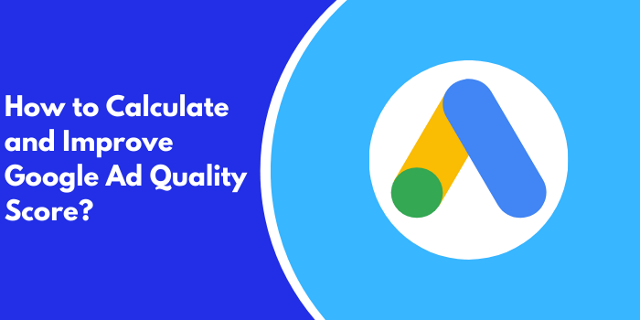How To Calculate And Improve Google Ad Quality Score?
How do you determine if your Google Ads are effective? Google uses a “quality score” to determine the frequency of people seeing your ads and how much they will cost you. This metric heavily influences current best practices. But the Google Ads platform is constantly changing, so it’s crucial to continuously calculate and improve these metrics.

Combining the quality score with other vital metrics, such as click-through rate (CTR) and cost-per-click (CPC), will help you better predict your campaign’s performance and optimize your ads. Therefore, your online marketing campaign’s success depends on understanding how to calculate and improve your quality score. It’s Google’s way of communicating with advertisers what they think about their keywords.
In the subsequent sections of this article, you will learn:
- The definition of Google ad quality score
- What a good, quality ad score entails
- Reasons for a bad quality Google ad score
- The importance of a quality Google ad quality
- How to calculate the Google ad quality score
- How to improve the Google ad quality score
So, let’s get started.
What is Google Ad Quality Score?

A quality score is attached to all Google Ads, ranging from 1 to 10. It reflects Google’s goal to make all information valuable and accessible and highlight the ad’s relevance. This score provides an estimation of the value of your PPC ads.
The score compares the keywords and landing pages you use with other advertisers. Google will use these factors to calculate a quality score, which helps it sort through all the ads.
What Is A Good Quality Google Ad Score?
The keyword you choose will determine a good quality Google ad score. For instance, if you have an e-commerce store, you can aim for a three-set rating. These include:
- Branded: Aim for 8 to 10.
- High-intent commercial: Ideally, aim between 7 and 9.
- Low-intent commercial: Target at least seven.
You might want to take action if your Google ranking is near the bottom. If your rating is 1-5, that’s a bad score.
Reasons For a Bad Quality Google Ad Score
You can end up on Google’s bottom rung for several reasons, but how can you do that? You may spend considerable time and effort on your campaigns, only to see no return on our actions.
Several factors contribute to this. While some are in your control, others are not. Some of these are:
- Poor Click-Through Rate (CTR): When you have a low CTR for a keyword, this may show Google you do not meet search query requirements. Over time, this will cost you money and harm your reputation.
- Irrelevancy: A poorly organized campaign with poor Google Ad copies can cause a low score if it becomes cluttered.
- Using Only Short-Tail Keywords: Your CTR will remain below 2% if you rely only on short-tail keywords. It is more effective to use long-tail varieties.
- Poor Quality Landing Page: Poor landing pages can cause a high bounce rate if someone clicks on your ad and finds a low-quality page. The search query doesn’t satisfy the user, which is not suitable for Google.
Why is Google Ad Quality Score Important?

Ad quality has a significant impact on how your Google Ads campaign will perform. One crucial area that matters is budget. More effective ads cost less per click than less effective ads. The CPC you pay for low-quality ads is likely to be close to your optimal CPC even if there is no competition. It is therefore crucial that your ads comply with Google’s quality standards.
When you have high-quality ads, Google shows them above the search results, so your audience can easily see them. The Quality Score feature allows you to tailor your ads for better results. You can use component analysis to see what needs improvement for a better user experience.
For instance, if your landing page isn’t as good as it should be, you can improve it, so it’s more relevant to your advertisement. Quality ads can generate more clicks and conversions.
How Is Google Quality Score Calculated?
Google calculates your score each time someone searches for something resulting in your ad showing up.
To calculate your score, it considers three factors:
- The expected CTR: Google estimates the likelihood of your ad’s viewers clicking on it. To do this, it examines your campaign history.
- Ad relevance: It determines the relevance of the keywords to the ad copy. The more relevant you are, the higher your ratings will be.
- Landing page experience: It determines your target page’s ability to meet people’s needs. Therefore, the long-term statistics of your account influence your ranking.
How to Improve Quality Score
Here’s how you can improve your Google Ads quality score:
Keyword Research
You can use keyword research to determine the most relevant keywords to use in your ad campaigns. Popular tools you can use include the Keyword Planner and platforms like SEMrush and Ahrefs. You can discover new terms for your campaigns by looking at your search terms. Using Dynamic Search Ads (DSA) can help you find more keywords.
Content Optimization
Each keyword has an importance level and a preferred location. For instance, specific keywords are crucial. If you miss them, your users will go to your competitors instead. Keyword location refers to where they appear in the content. The title is the most crucial part of any document, followed by headings, subheadings, and content. It’s vital to perform keyword research to optimize your content. Excellent research will allow you to include all relevant keywords in your work.
Efficient PPC
While it’s vital to keep users on your landing pages and encourage them to click through as much as possible, they need first to connect. You can test multiple titles aligned with your target audience to become more efficient. You will improve your Google quality score as more people click on your ads.
Better Landing Pages
As this is the landing page searchers will arrive at, you must adequately optimize it for your campaign and accomplish its goals. For instance, be sure it is:
- Adapted for smartphones.
- Loads pages quickly.
- The copy on the landing page uses relevant keywords.
Conclusion
The road to mastery takes time. You can improve your ads with some strategic decision-making and concerted effort, which leads to a higher CTR and ultimately a higher quality score. Eventually, you’ll end up with a very successful campaign.


